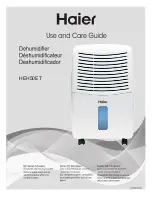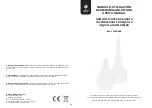
17
Failure to lubricate the air motor will result in motor failure.
5.8
Electric Motor (radiator fan)
Electric aftercooler fan motors (#9) are optional and are available with a 115/208-230 vac 1 ph,
208-230/460 vac 3 ph, 230 vac 1 ph, or 230/460 vac 3 ph rating depending on the size of the
aftercooler. The motor characteristics are on the nameplate attached to the motor (see to Section
11.0, Table 2 for motor specifications). The motor should be connected to a power supply of the
same characteristics as the motor. Be sure to provide proper fusing to prevent possible motor
burnout. Before starting motor, follow the manufacturer’s installation recommendations. Turn
the fan by hand to eliminate possible motor burnout in the event the fan has been damaged in
shipment. Observe operation after motor is started for the first time.
To prevent possible electrical shock, it is important to properly ground this unit using the
grounding screw provided. Be sure not to disconnect the motor grounding wire when making
this connection.
Power connections to AirPrep System with electric motors expose operators to high electrical
voltages. Contact with high electrical voltages can result in serious injury or death. Only
qualified personnel should install or perform maintenance on the electrical system.
5.9 Separator
Tank
After the compressed air leaves the aftercooler, it enters the separator tank (#20). The separator
tank allows the compressed air to expand causing moisture condensation. The air enters the tank
at a low elevation through a tangential inlet. The cyclonic movement causes the water droplets in
the air to drop to the bottom of the tank. As the air flow rises through the tank it passes through a
bed of marbles (#15) then into the deliquescent/desiccant tablets (#14). The absorbed/adsorbed
moisture then drops to the bottom of the separator tank. The moisture collected in the separator
tank can be drained through the drain ball valve (#19). This ball valve should be left slightly
open anytime the system is in operation. This allows water to be drained as it is filtered from the
air. After each use the drain ball valve should be completely opened to drain all the moisture that
has accumulated. The drain ball valve (#19) should be left closed anytime the unit is not in use.
The Air Prep System separator tank is a Pressurized Vessel. Propelled objects will cause serious
injury or death. Depressurize vessel before performing any maintenance. See Section 6.2.
5.10 Deliquescent/Desiccant
Tablets
The volume of the separator tank above the marble bed (#15) can be filled with deliquescent or
desiccant tablets (#14). The tablets can be filled into the separator tank through the handway
(#10) at the top. The deliquescent/desiccant tablets are not furnished with the AirPrep System.
These materials are designed to lower the dew point of the compressed air by removing
moisture. Deliquescent tablets absorb moisture from the compressed air, and in doing so dissolve
into a brine solution that drops to the bottom of the separator tank. Desiccant tablets adsorb
moisture (adhesion to the contacting surface) from the compressed air. The water droplets then
drop to the bottom of the separator tank. In either case the moisture/brine solution can be drained
through the ball valve (#19) at the bottom of the tank. It is important to close all drain and outlet
valves anytime the AirPrep System is not in use. This is to prevent moist air entering from
outside of the system.
















































